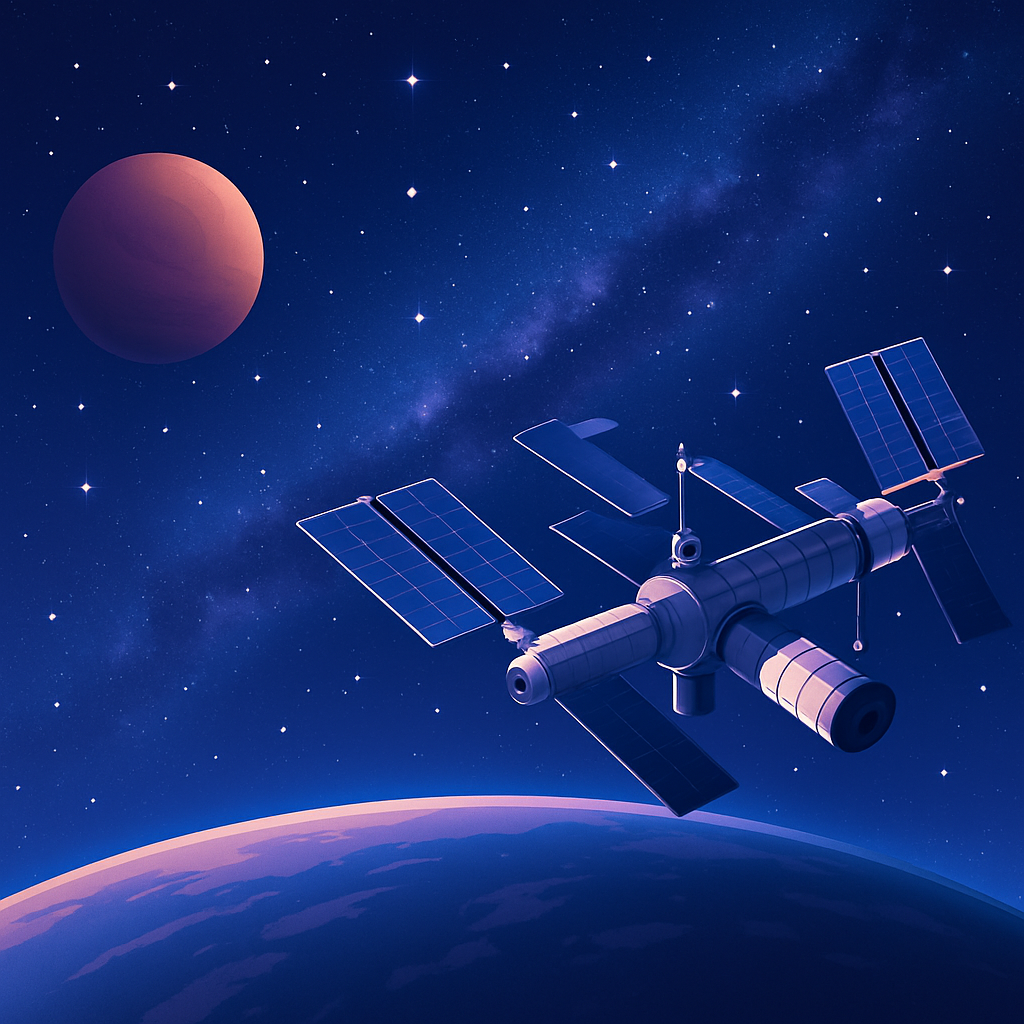🚀 궤도 위의 집 — 천문학이 만든 우주정거장의 하루
지구에서 약 400km 위, **국제우주정거장(ISS)**은 시속 28,000km로 지구를 돌고 있다. 하루에 지구를 16바퀴나 도는 셈이다.
이곳은 단순한 연구실이 아니라, 인류가 우주에서 장기 거주하는 실험장이다. 그리고 그 배경에는 천문학의 축적된 데이터가 있다.
🌌 천문학이 만든 ‘정확한 시간표’
우주정거장은 태양빛과 지구 그림자를 반복적으로 통과한다.
하루에 16번의 ‘해돋이’와 ‘해넘이’를 맞이하기 때문에, 시간 개념이 지구와 다르다.
천문학자들은 **궤도 역학(orbital mechanics)**을 기반으로, 우주정거장의 이동 경로와 속도를 계산한다.
이 데이터 덕분에 승무원들은 실험 시간, 운동 시간, 식사 시간을 정확히 맞출 수 있다.
🛰 지구 밖에서 하는 천문학
ISS는 지상 망원경이 볼 수 없는 파장대의 빛을 관측한다.
대기권 밖에서는 적외선·자외선 관측이 가능하기 때문에, 지구에서 불가능했던 데이터 수집이 가능하다.
예를 들어, 허블 우주망원경은 ISS보다 더 높은 궤도에서 작동하지만, ISS에서도 소형 망원경 실험이 꾸준히 이뤄진다.
⚙️ 우주 생활의 과학
ISS에서는 미세중력 환경에서의 식물 재배, 액체 이동 실험, 인체 반응 연구가 진행된다.
이는 장기 우주 탐사—예를 들어 화성 탐사—를 위해 필수적인 데이터다.
이 또한 천문학과 물리학, 생물학이 합쳐져 만들어진 ‘우주 과학의 교차점’이다.
🌍 지구로 보내는 데이터
ISS에서 수집한 데이터는 매일 지구로 전송된다.
이 과정에는 위성 통신 네트워크와 지상국의 안테나, 그리고 천문학적 좌표계가 쓰인다.
지구와 우주정거장 사이의 정확한 위치 계산은, 관측 위성 운영과도 똑같이 진행된다.
🔭 우리가 배우는 점
우주정거장은 단순한 우주 호텔이 아니다.
그것은 천문학이 설계한 실시간 실험실이며, 인류가 ‘우주에서 사는 법’을 배우는 학교다.
ISS를 이해하는 건 곧, 미래의 달 기지나 화성 기지 건설에 대한 첫걸음을 이해하는 것이다.
음소분석 코너
1. velocity
• 발음기호: /vəˈlɒs.ə.ti/ (영국)
/vəˈlɑː.sə.ti/ (미국)
• 발음 분석:
1. /və/ — [v] 무성·유성의 경계에 가까운 유성 마찰음 (윗니와 아랫입술 맞물림), 뒤에 [ə] 약화 모음
2. /ˈlɒs/ — [l] 혀끝을 윗잇몸에 닿게 하는 측음, [ɒ] 영국식 단모음(미국은 [ɑː]), [s] 무성 치경 마찰음
3. /ə/ — 약화 모음 schwa
4. /ti/ — [t] 무성 치경 파열음, [i] 긴 고모음
• 뜻: 속도, 빠르기 (물리학에서 많이 사용)
• 발음 팁:
• 첫 음절 [və]는 아주 약하게, 강세는
두 번째 음절 **-los-**에 둔다.
• 영국식은 [ɒ], 미국식은 [ɑː]로 구분해서
발음하면 깔끔하다.
2. rehearsal
• 발음기호: /rɪˈhɜː.səl/ (영국) /rɪˈhɝː.səl/ (미국)
• 발음 분석:
1. /rɪ/ — [r] 혀를 살짝 말아올리는 유음,
[ɪ] 짧은 전설 고모음
2. /ˈhɜː/ — [h] 무성 성문 마찰음,
[ɜː] 중설 장모음(미국식은 [ɝː]로 r-colored)
3. /səl/ — [s] 무성 치경 마찰음, [ə] schwa,
[l] 혀끝을 잇몸에 붙이는 측음
• 뜻: 리허설, 예행연습
• 발음 팁:
• 강세는 두 번째 음절 **-her-**에 둔다.
• 미국식은 [ɝː]에서 r 발음을 분명하게 말아준다.
• [h]는 성대를 진동시키지 않고,
공기만 내뿜는 소리로 가볍게 처리.

🚀 The Universe’s Rest Stop — Life Lessons from the Space Station
When the International Space Station (ISS) appears in the night sky, it’s not just a metal module orbiting Earth. It’s humanity’s shared “rest stop” in space — a place to pause, observe, and prepare for the next journey.
In a world where everything moves at the speed of a notification, the ISS reminds us that sometimes, orbiting without rushing forward is part of progress.
1. Orbiting Is Not Stagnation
In astronomy, an object in stable orbit may look like it’s simply circling, but it’s actually maintaining perfect balance between gravity and velocity. The ISS is a living example — traveling at 28,000 km/h while staying in place relative to Earth’s surface.
Life works the same way. You might feel you’re “going in circles” in work or relationships, but sometimes that’s the necessary phase to gather data, observe patterns, and avoid crashing into the unknown.
2. The Importance of Docking
A space station thrives on its docking ports. Spacecraft arrive to deliver supplies, exchange crew, and bring new experiments. Without these connection points, the ISS couldn’t sustain its mission.
In our own lives, docking points are the relationships, mentors, or routines that resupply our energy. Without them, we risk isolation — and in space, as in life, isolation can be deadly.
3. Microgravity and Perspective
Inside the ISS, gravity’s absence changes how astronauts move, eat, and even think. Everyday assumptions — like “up” and “down” — no longer apply.
This shift mirrors how breaking free from your own mental gravity can spark creativity. When you leave your comfort zone, even basic problems demand new solutions — and that’s where true growth begins.
4. Maintenance Is Survival
The ISS is constantly under maintenance: repairing solar panels, checking oxygen levels, and updating software. Even small neglect could be catastrophic.
Our own “life station” needs the same discipline — maintaining health, relationships, and skills before breakdowns occur. In space, there are no convenience stores for quick fixes; the same is true for our long-term well-being.
5. Space Is a Team Effort
The ISS is the result of over 15 nations working together — a floating example of cooperation beyond politics. Astronauts share food, experiments, and even jokes despite cultural differences.
In your own orbit, collaboration often beats competition. The best missions are rarely solo flights.
The ISS is not just a lab in the sky. It’s a metaphor for sustaining momentum, building connections, and adapting to new environments. Whether you’re orbiting a personal goal or maintaining a steady path in life, remember — stability is also progress, and every well-run station is a launchpad for the next leap.
#우주정거장 #국제우주정거장 #ISS #천문학 #우주탐사 #지구궤도 #우주과학 #우주기술 #우주연구 #우주사진